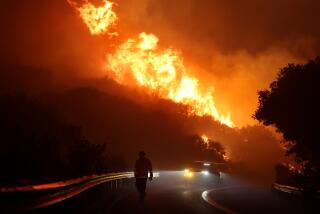HOME SAFETY : Extinguisher Can Save Possessions as Well as Lives
- Share via
Fire extinguishers are important safety precautions that every home should have. Quick use of an extinguisher on a small fire can prevent it from becoming a serious blaze.
In case of a larger fire, always call the fire department first. Never try to fight it by yourself.
If a small fire begins to spread, have everyone leave the house immediately.
There are three categories of fire--A, B and C--by which fire extinguishers are rated. Each kind of fire is extinguished differently:
* “A” fires burn to ash. They are fueled by wood, cloth, paper, most rubbish and some plastics. Water will put them out.
* “B” fires bubble. They involve flammable liquids and grease. Most kitchen fires are of this type. Never throw water on them; it will only splatter and spread the flames. For oven or broiler fires, turn off the heat and shut the door. If meat catches fire, put a lid over it. If the fire is on top of the stove, turn off the burner if possible, leave the pan where it is and smother the flames with a lid. Or douse the fire with handfuls of baking soda or salt.
Never put baking powder, sugar or flour on a fire. Sugar will burn and baking powder or flour dust may explode.
* “C” fires involve electrical power. These occur in electrical wiring or appliances.
Unplug the appliance or shut off the power and use an all-purpose (“ABC”) fire extinguisher. Never throw water on a “C” fire; a serious shock or even electrocution may result.
An extinguisher’s letter rating--A, B, or C, or a combination of two or three--indicates what kind of fires it can put out. The number preceding the letter rating, for example 1-A or 5-B, indicates the size of a standard test fire that the extinguisher can put out; the higher the number, the greater the extinguisher’s firefighting capacity.
Fire extinguishers are available in rechargeable and non-rechargeable (disposable) types. An extinguisher that cannot be recharged or that doesn’t have a gauge is not as reliable as a rechargeable type. If you have a disposable extinguisher, it’s a good idea to replace it.
Rechargeable fire extinguishers are best because they have a gauge that indicates the pressure in the tank.
Inspect the pressure gauge periodically. If the pressure drops, or if the extinguisher is used even briefly, have it recharged by an extinguisher service company.
Before buying a fire extinguisher, check to see that it is easy to handle, especially by an elderly person or a child.
Make sure that the operating directions, located on the canister, are clear.
It is also important that the extinguisher carry the Underwriter’s Laboratory (UL) or Factory Mutual (FM) seal of approval. This indicates that the extinguisher model has been tested and provides the protection claimed on the label.
*
Install extinguishers in the kitchen and in or near the living room, bedrooms, basement and garage. Locate them in plain view, away from but convenient to fire hazards. Make sure the entire family knows how to use them. Keep one nearby when you are doing chores such as spray painting or car repairs.
For a car, select a 2 1/2-pound dry-chemical fire extinguisher (rated for class A, B, and C fires) to fight small interior fires that might be caused by a stray ash or an electrical malfunction.
Keep the extinguisher inside the car, under the front seat or in the glove compartment. In the time it would take to retrieve the extinguisher from the trunk, the fire could be out of control.

